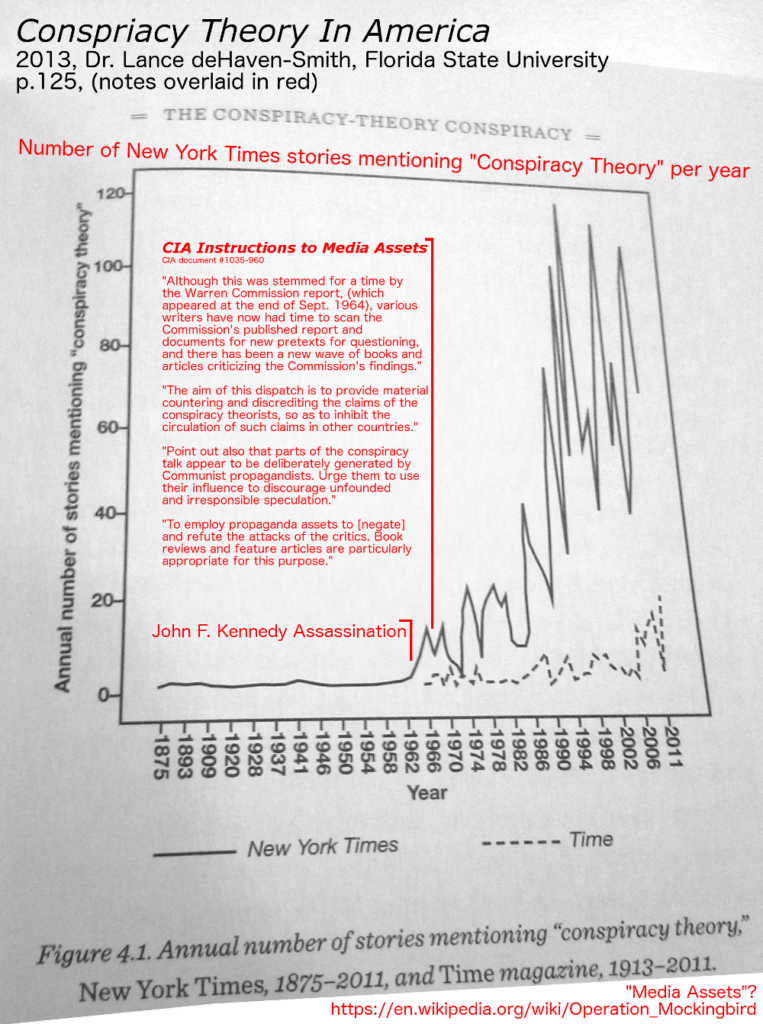CIA Instructions to Media Assets, document #1035-960
“Although this was stemmed for a time by the Warren Commission report, (which appeared at the end of Sept. 1964), various writers have now had time to scan the Commission’s published report and documents for new pretexts for questioning, and there has been a new wave of books and articles criticizing the Commission’s findings.”
“The aim of this dispatch is to provide material countering and discrediting the claims of the conspiracy theorists, so as to inhibit the circulation of such claims in other countries.”
“Point out also that parts of the conspiracy talk appear to be deliberately generated by Communist propagandists. Urge them to use their influence to discourage unfounded and irresponsible speculation.”
“To employ propaganda assets to [negate] and refute the attacks of the critics. Book reviews and feature articles are particularly appropriate for this purpose.”
If you are unsure about what “Media Assets” are, you might start with “Operation Mockingbird” – https://en.wikipedia.org/wiki/Operation_Mockingbird
Favorite Quotes from Conspiracy Theory In America, by Dr. Lance deHaven-Smith, Florida State University
http://www.amazon.com/Conspiracy-Theory-America-Discovering/dp/0292757697/
(p.5) In their law review article, Sunsteing and Vermeule expand this idea and propose covert government action reminiscent of the FBI’s efforts against the civil rights and antiwar movements in the 1960s. They consider a number of options for countering the influence of conspiracy theories, including public information campaigns, censorship, and fines for Internet service providers hosting conspiracy-theory websites.
(p.9) In a 2006 peer-reviewed journal article I introduced the concept of the State Crime Against Democracy (SCAD) to displace the term “conspiracy theory.” I say displace rather than replace because SCAD is not another name for conspiracy theory; it is a name for the type of wrong-doing about which the conspiracy-theory label discourages us from speaking. Basically, the term “conspiracy theory” is applied pejoratively to allegations of official wrongdoing that have not been substantiated by public officials themselves.
(p.20) Far from being more factual and plausible than theories positing political crimes and intrigues, coincidences pile up, which they have been doing for decades in the U.S. It is like flipping a coin ten times and it always falls on heads. In general, as SCADs and suspected SCADs pile up, the odds of coincidence drop rapidly.
(p.39) The only author on conspiracy theory to have faced this issue squarely is historian Kathryn Olmsted. In her words, “A conspiracy occurs when two or more people collude to abuse power or break the law. A conspiracy theory is a proposal about a conspiracy that may or may not be true; it has not yet been proven.”
(p.69) As President Eisenhower warned in his farewell address: military leaders and armament manufacturers had become a “military-industrial complex” capable of influencing the entire direction of American government. Since Eisenhower’s day, the military-industrial complex has expanded while other, related complexes have formed around energy, finance, and pharmaceutical interests. Complexes differ from iron triangles in their command over resources that affect overall societal conditions, mass perceptions, and political priorities.
(p.73) The lesson that Americans, Germans, and others should have drawn from the evidence presented at Nuremberg is that modern liberal democracies are vulnerable to being hijacked by authoritarian leaders willing to carry out ruthless conspiracies.
(p.101) Scholars of all persuasions generally agree that the range of ideas considered in American politics is very limited and is slanted in ways benefiting political, military, and/or business elites. No serious student of American politics would expect any new president to be able to recast or break free of this circumscribed consensus and take U.S. policy in a radically different direction.
(p.105) To the extent that national security elites are influencing national political priorities by manipulating the constellation of issues confronting the nation, all of the theories in the social sciences and their associated research programs are studying downstream phenomena while the real explanation of events resides earlier in time and higher in America’s authoritative hierarchy. In other words, it is quite possible that the social sciences are studying shadows and that the people making the shadows are designing them for effect. Of course, this was how Plato described the situation of the citizens except that in his story, which we must assume was a noble lie, the philosophers were helping citizens understand the shadows, not using the shadows for social control.

